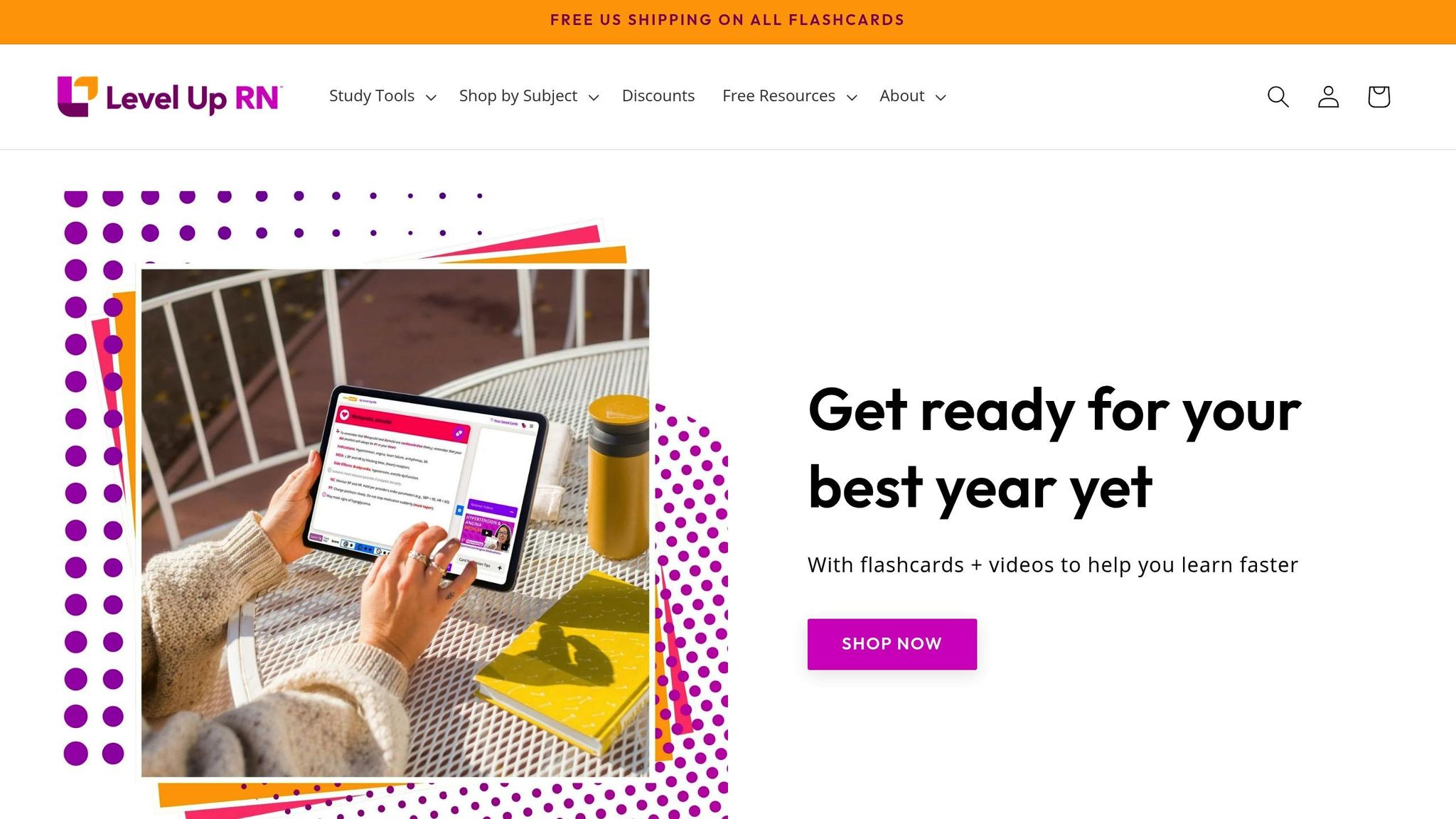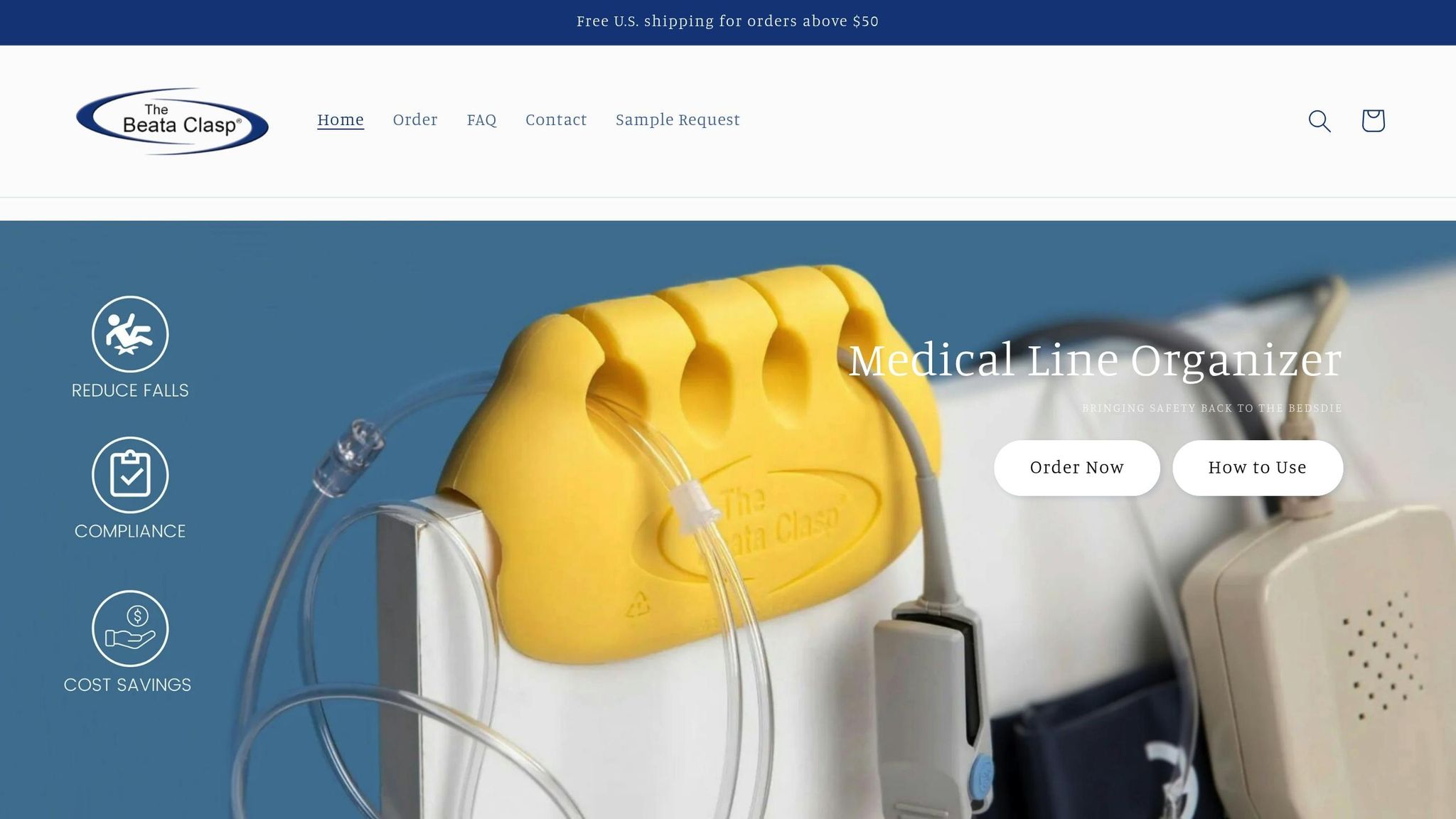Managing IV lines is a daily challenge in healthcare, with disorganized tubing often leading to medication errors, alarm fatigue, and safety risks. The new Line Management Awareness Program aims to solve these issues by improving IV line organization, reducing errors, and boosting patient outcomes. Here's what it offers:
- Key Goals: Reduce alarm frequency, prevent medication errors, and standardize protocols.
- Training: Hands-on sessions, peer mentorship, and ongoing assessments to ensure staff mastery.
- Practical Tools: Solutions like the nurse-designed BeataClasp to simplify line management and improve safety.
- Compliance: Aligns with ISMP, AAMI, and CMS standards to meet safety and regulatory requirements.
The program combines evidence-based strategies with easy-to-use tools, helping healthcare teams deliver safer, more efficient care while addressing common IV line challenges.
IV Complications - Pharmacology Basics | @LevelUpRN

What Is the Line Management Awareness Program
The Line Management Awareness Program is designed to tackle challenges related to IV line disorganization and safety. By combining evidence-based protocols, staff training, and practical tools, the program streamlines IV therapy management, helping to reduce errors and improve patient outcomes. Below, we’ll explore the program’s goals, training components, and alignment with national standards.
Managing IV lines effectively requires coordinated training, clear procedures, and the right tools. This program offers actionable solutions to enhance safety and make workflows more efficient.
Program Goals and Objectives
The program focuses on reducing preventable IV complications by addressing alarm frequency, medication errors, and protocol standardization. One major goal is to lower the number of operational alarms while ensuring critical alerts receive timely responses.
A key aspect of the program is eliminating the need for nurses to override alarms due to frequent false alerts. This practice can mask genuine safety issues, putting patients at risk. By addressing this, the program enhances patient care and safety.
Another priority is optimizing workflows to help nursing staff manage their time more efficiently. By cutting down on delays in resolving alarms and reducing unnecessary interruptions, nurses can dedicate more attention to direct patient care. Additionally, standardizing IV line management protocols across departments ensures consistency. This uniformity minimizes confusion during patient transfers and creates a more predictable environment for both staff and patients.
Training and Education Components
The program’s training modules are designed to equip nurses with the skills they need for effective IV line management. These modules cover key topics such as IV line organization, infection control practices, and proper use of organizational tools. The training accommodates various learning styles and can be completed during regular shifts, ensuring minimal disruption to patient care.
Hands-on demonstration sessions form a critical part of the training. These sessions allow nurses to practice techniques in a controlled setting before applying them in real-world scenarios. For example, they might work on organizing multiple IV lines during emergencies or maintaining order during patient transport.
To ensure long-term success, the program includes ongoing assessments. These assessments combine written evaluations with practical demonstrations, helping to confirm that staff retain and apply the skills they’ve learned. Refresher training is also available to maintain competency over time.
The program also emphasizes peer mentorship. Experienced nurses who excel in IV line management are paired with colleagues who may need additional support. This collaborative approach encourages knowledge sharing and continuous improvement within the team.
Meeting National Standards
The Line Management Awareness Program aligns with industry guidelines to address IV line-related complications. It incorporates recommendations from the Institute for Safe Medication Practices (ISMP), particularly regarding organized IV line management and medication safety. By focusing on minimizing programming errors and implementing dose error reduction systems, the program reflects ISMP’s best practices.
Standards from the American Association of Medical Instrumentation (AAMI) are also embedded in the program. These standards emphasize infusion pump safety and discourage unsafe workarounds. By addressing AAMI’s priorities, the program helps healthcare teams comply with critical safety recommendations.
Additionally, the program meets the requirements of the Joint Commission and the Centers for Medicare & Medicaid Services (CMS). Its emphasis on preventing hospital-acquired complications, rigorous infection control, and error reduction aligns with CMS initiatives aimed at improving patient safety and reducing preventable readmissions. Through these efforts, the program reinforces a commitment to delivering high-quality care.
Practical Solutions for Better IV Line Organization
The Line Management Awareness Program highlights practical ways to improve IV line organization, ensuring safer patient care and smoother workflows. Across the United States, healthcare facilities have adopted these strategies to minimize complications, streamline processes, and enhance patient outcomes.
Proven Methods That Work
One of the cornerstones of effective IV line organization is the use of standardized labeling systems. Every line should clearly display the medication name, concentration, and administration route, with a consistent color-coding system. For instance, many facilities use white labels for primary medications, yellow for secondary infusions, and red for high-alert drugs like insulin or heparin. This visual system helps nurses quickly identify lines, especially during emergencies or patient transfers.
Implementing line tracing protocols is another critical step. This involves tracing each line from the patient to the infusion source before administering medication. While this process takes only 15–30 seconds per line, it significantly reduces the risk of wrong-route administration errors, ensuring patient safety.
Organizing lines based on height is also effective. Primary lines should be placed at the highest point, followed by secondary medications, with maintenance fluids positioned lowest. This arrangement takes advantage of gravity to maintain proper flow rates and prevents medication incompatibilities or backflow.
Using dedicated line management tools can further enhance organization. For example, the BeataClasp, designed by nurses, separates lines, prevents floor contact, and includes antimicrobial protection. Its high-alert color coding ensures rapid identification in critical care settings, directly supporting infection control efforts.
Infection Control Best Practices
Proper IV line organization plays a vital role in reducing infection risks. Line separation techniques are crucial to maintaining sterile conditions and preventing cross-contamination. Lines should never touch the floor, bed rails, or other potentially contaminated surfaces. Tangled lines increase the chance of pathogen introduction, especially at connection points where sterile barriers can be compromised.
To maintain sterility, inspect connection points every four hours to address contamination risks. Replace any compromised lines immediately, following facility protocols.
Environmental considerations also matter. IV poles should be positioned to avoid line crossing, and enough space should be maintained around the patient bed to allow for proper organization. Additionally, using latex-free materials is essential to avoid complications for patients with latex sensitivities.
Clean handling procedures are another key aspect. Nurses must perform hand hygiene before and after handling lines. Gloves should be changed when switching between different lines, and sterile technique must be maintained when accessing ports or making connections. Proper organization ensures that lines are easily accessible, making these practices more manageable.
Staff Training and Assessment
Effective IV line management starts with competency-based training. Nurses should receive both theoretical instruction and hands-on practice with simulated IV setups. Training should also cover high-pressure scenarios where quick line identification is critical for patient safety.
Peer mentorship reinforces these skills, providing ongoing support and encouraging continuous improvement. This collaborative approach builds confidence and ensures adherence to best practices.
Regular skill assessments are essential for maintaining competency. These evaluations should include practical demonstrations of line organization, proper use of management tools, and emergency response techniques. Documenting these assessments supports regulatory compliance and tracks individual progress.
Encouraging continuous improvement processes allows staff to identify challenges and share solutions. Regular team meetings can focus on addressing common issues and refining strategies. Effective training and open communication are key to ensuring consistent implementation of safety protocols and improving patient care.
sbb-itb-f779e18
Nurse-Designed Solutions: The BeataClasp

Two registered nurses, inspired by the daily challenges of managing IV lines, created the BeataClasp to tackle issues like entanglement, contamination, and inefficiencies in workflow. Unlike basic organizers, the BeataClasp was shaped by insights from healthcare professionals, ensuring it prioritizes both patient safety and staff productivity. The result? A tool that seamlessly integrates into existing routines while addressing multiple safety concerns at once. Let’s dive into its features, pricing, and how it stacks up against traditional methods.
Key Features and Benefits
The BeataClasp stands out with its antimicrobial surface, designed to inhibit bacterial growth. This is a game-changer in healthcare settings where infection control is always a top priority.
Its high-alert color coding makes it easy to spot in busy clinical environments. This feature proves especially useful during emergencies or patient transfers, where quick access and identification of lines can make all the difference.
By preventing line entanglement, the BeataClasp reduces the risk of accidental disconnections, medication errors, and workflow interruptions. It keeps lines accessible for monitoring and medication administration while ensuring they stay off contaminated surfaces like floors.
Another standout feature is its versatility. The BeataClasp works with various IV setups and can be used in multiple settings, from ICU units to general medical floors and even home care. Whether for single or multiple patients, its adaptable design meets diverse healthcare needs.
The easy-to-clean surface supports infection control protocols, allowing it to be wiped down with standard hospital disinfectants without compromising its antimicrobial properties or durability. Plus, it’s latex-free, eliminating concerns about allergic reactions for both patients and staff.
Pricing Options
The BeataClasp is offered at competitive price points to suit different needs:
- Individual Unit: $19.95 per unit – Ideal for small-scale testing or individual department use.
- Evaluation Pack: $163.00 for 10 units – A budget-friendly option for departmental trials and comprehensive assessments.
- Bulk Order: $467.50 for 25 units – The best value at approximately $18.70 per unit, perfect for larger-scale implementations.
BeataClasp vs. Standard Methods Comparison
| Feature | BeataClasp | Standard Methods |
|---|---|---|
| Safety Features | Antimicrobial surface, high-alert color coding, prevents floor contact | Basic organization |
| Ease of Cleaning | Wipes clean with standard disinfectants | Often difficult to sanitize properly |
| Versatility | Works across multiple settings and line configurations | Limited adaptability, setting-specific |
| Cost-Effectiveness | Reusable, reduces time spent on line management | Higher labor costs, reliance on disposables |
| Infection Control | Built-in antimicrobial protection, reduces contamination | Relies on external cleaning protocols |
This side-by-side comparison highlights how the BeataClasp addresses multiple challenges in one solution. Standard methods, such as tape or basic clips, often focus on a single aspect of line management and can add to cleaning difficulties. Many traditional tools have crevices or materials that can harbor bacteria, whereas the BeataClasp’s smooth, antimicrobial surface eliminates these concerns while maintaining essential organizational benefits.
As part of the broader Line Management Awareness Program, the BeataClasp is a shining example of nurse-driven innovation aimed at improving patient safety and streamlining healthcare workflows.
How to Implement the Program and Track Results
Rolling out the Line Management Awareness Program takes thoughtful planning and a step-by-step approach. A smooth implementation not only encourages staff adoption but also enhances patient safety. With nurse-designed tools like the BeataClasp, managing IV lines becomes more efficient and organized.
Adding to Clinical Workflows
Start by assembling a multidisciplinary team that includes nursing leaders, infection control experts, and quality improvement staff. This team should evaluate current IV line management practices, pinpoint challenges, and determine priority areas for improvement.
Appoint unit champions - experienced nurses trained to guide their peers through the transition. These champions provide real-time support and mentorship, ensuring a smoother adjustment for the entire team.
Begin with a pilot program in one or two units. This allows staff to get comfortable with the changes and provides an opportunity to fine-tune workflows. The BeataClasp is designed to be user-friendly, but giving staff time to practice with it in non-urgent situations can boost confidence and proficiency.
Seamless integration with existing protocols is key. Add BeataClasp placement to standard documentation and update shift handoff procedures to include IV line organization. The device’s color-coded design helps it stand out during patient transfers and emergencies, making it easier to manage.
Plan the rollout during periods of stable staffing, and ensure there’s an adequate supply of BeataClasp devices. Establish clear restocking processes to avoid disruptions.
Once the program is in place, it’s time to measure its impact.
Measuring Success
To evaluate the program’s effectiveness, track key metrics like infection rates, staff efficiency, incident reports, satisfaction levels, and cost savings.
- Infection rates are a primary measure of success. Monitor central line-associated bloodstream infections (CLABSIs) and peripheral IV complications before and after implementation. Many facilities notice improvements within 90 days.
- Time and motion studies can reveal how much time nurses save managing IV lines during routine care, medication administration, and patient transfers.
- Incident reports provide valuable insights. Look for reductions in IV line disconnections, medication errors, and patient falls caused by line entanglement.
- Staff satisfaction surveys gauge how well the program is being received. Ask about ease of use, time savings, and perceived patient safety improvements. High satisfaction often signals long-term program success.
- Cost analysis highlights savings from fewer infections, reduced nursing time, and decreased adverse events. The BeataClasp’s reusable design can also lower costs compared to disposable alternatives.
Additionally, patient satisfaction scores may improve as staff become more skilled and efficient in managing IV lines.
Regulatory and Workplace Considerations
Beyond clinical outcomes, regulatory and workplace factors demonstrate the program’s value. The Line Management Awareness Program aligns with Joint Commission standards for infection prevention and patient safety, supporting National Patient Safety Goals by reducing healthcare-associated infections and improving medication administration accuracy.
Centers for Medicare & Medicaid Services (CMS) quality measures also benefit. Better line management practices can positively impact scores for the Hospital-Acquired Condition Reduction Program and Value-Based Purchasing metrics.
OSHA compliance is another consideration. The BeataClasp’s latex-free design eliminates allergy risks for staff, and its easy-to-clean surface supports infection control without introducing additional chemical exposure concerns.
State health department regulations often emphasize infection prevention and patient safety - areas the program directly addresses. Keep thorough documentation of implementation and outcomes to demonstrate compliance during inspections.
Workplace culture plays a big role in the program’s success. Address resistance to change by highlighting the BeataClasp’s nurse-designed origins and involving staff in the evaluation process. Recognize early adopters to encourage broader acceptance.
When planning the budget, consider initial device costs, training time, and ongoing evaluation efforts. The BeataClasp is priced competitively at $18.70 per unit for bulk orders, with an Evaluation Pack option available at $163.00 for 10 units. This allows facilities to test the program’s value before committing to larger purchases.
Finally, update policies and procedures to reflect the new protocols, maintain training records, and track outcome metrics. This documentation not only supports regulatory compliance but also provides evidence of the program’s effectiveness during accreditation surveys.
Conclusion: Better Safety and Efficiency with the Line Management Awareness Program
The Line Management Awareness Program represents a significant step forward in improving IV therapy management through practical, evidence-based strategies. With IV complication rates reported as high as 53%, the need for better training and updated protocols is clear. These complications aren't just numbers - they impact real lives, leading to discomfort, extended hospital stays, increased mortality rates, and ballooning healthcare costs.
Consider the data: patients experiencing IV complications face a 3.6% mortality rate compared to 0.7% for those without complications. Their hospital stays average six days instead of less than four, and the associated costs climb to nearly $11,000 versus about $7,000. These statistics highlight the critical need for action.
What sets this program apart is its reliance on frontline expertise. A standout example is the BeataClasp, a nurse-driven innovation designed to improve IV line safety and simplify management. By reducing complications and easing the workload for clinical staff, this tool not only enhances patient outcomes but also improves the daily experience for healthcare providers.
Additionally, the BeataClasp's cost-effectiveness makes it a smart investment. Fewer complications translate to shorter hospital stays, lower costs, and improved patient satisfaction. By adopting the Line Management Awareness Program, healthcare facilities align themselves with the evidence-based standards of the Infusion Nurses Society, signaling a commitment to better care and operational excellence.
FAQs
How does the Line Management Awareness Program help improve patient safety and prevent medication errors?
The Line Management Awareness Program (LMAP) focuses on improving patient safety and reducing medication errors by implementing clear, standardized protocols for managing IV lines. These guidelines address common risks like improper line placement, contamination, and related complications, ensuring a more reliable and safe process.
The program also prioritizes nurse education through practical training sessions and certifications. These hands-on experiences give healthcare professionals the tools and knowledge they need to handle IV line care and maintenance effectively. By combining well-defined procedures with comprehensive training, LMAP not only enhances patient safety but also streamlines workflows for medical staff.
What does the Line Management Awareness Program offer to train and assess healthcare staff?
The Line Management Awareness Program is designed to deliver focused training aimed at improving the organization and safety of IV lines. It emphasizes standardized protocols, safety measures, and regulatory requirements, ensuring healthcare staff have the tools and knowledge needed to handle IV therapy with confidence.
To track progress, the program incorporates knowledge tests and performance evaluations. These assessments ensure that healthcare professionals are skilled and self-assured in managing IV lines, which helps minimize errors and improves the quality of patient care.
How does the BeataClasp improve IV line management and what are its main benefits over traditional methods?
The BeataClasp offers a game-changing approach to managing IV lines with its nurse-designed, antimicrobial, and adhesive-free design. It keeps IV lines neatly organized, off potentially contaminated surfaces, and easy to trace. This thoughtful solution helps reduce common risks like tangling, accidental dislodgement, and contamination, promoting a safer and smoother workflow for healthcare professionals.
Here’s what makes the BeataClasp stand out:
- Prevents line impingement by securely holding tubes in place.
- Simplifies workflows by reducing errors and maintaining order.
- Boosts patient safety with better IV line organization and management.
Unlike the old-fashioned manual methods, the BeataClasp provides a dependable, easy-to-use tool designed to meet the fast-paced demands of today’s healthcare settings.
